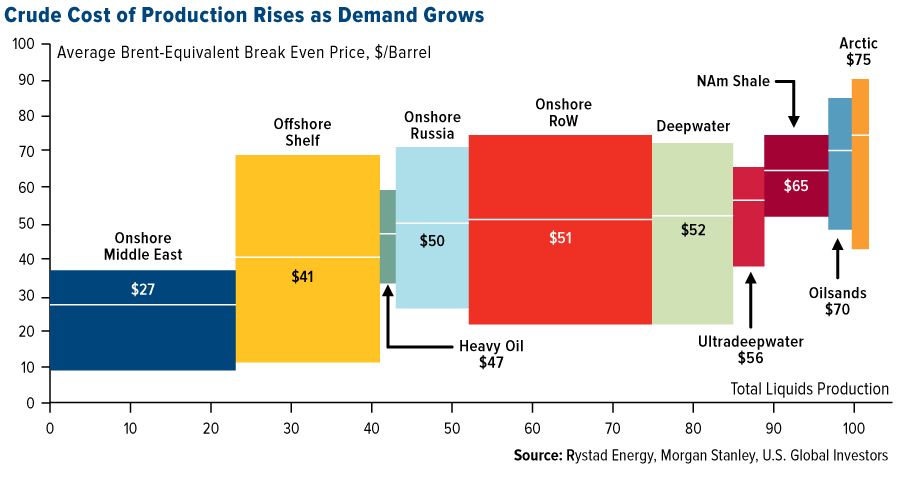The Ever Suffering Oil Industry

Can you believe that not so long ago, oil was trading over $100 a barrel? This was our reality back in June of 2014, right before OPEC announced they will increase their production. Since then, it’s been a complete nightmare for most investors active in the oil industry. The barrel dropped, and the US kept pumping more oil ever since. The OPEC strategy was to cut the US oil market with low prices, but it hasn’t worked so far:
(Click on image to enlarge)

And this is why oil keeps dropping: the offer is increasing faster than the demand. As the offer grows, the price of a barrel continues its descent down to roughly $35. Now, it is obvious that we are in the middle of a great speculation scheme. In order to not cede to panic, one must understand what is going on. Here’s my theory.
By looking at the graph below, you will notice that we have reached a price where most countries can’t produce oil for a profit:
(Click on image to enlarge)

This chart is the most recent I have found and is dated December 2014. I recently attended a financial conference with a similar chart using like prices. Overall, you can expect the Middle East to produce oil with a profit until the barrel hits $25-$30. Most countries are able to make profitable oil exploitation with price around $50-55 per barrel. Towards the end of this graph, we see the USA shale gas and Canadian oil sands production requiring a barrel between $65 and $75 to become interesting.
Having a barrel under $40 means much of the world is producing at a loss. In other words; we have seen many companies closing their doors and more are to come. Smaller producers will have to stop their operations at best or resort to declaring bankruptcy at one point in time. This will have an effect on the offer and should enable higher prices to a more balanced range around $50-$55 by the end of 2016.
Another factor leading me to think oil will climb back above the psychological bar of $50 a barrel is the growing budget problems in Middle Eastern countries. They are currently protecting their market share in the oil industry, while paying the price of lower profitability. Other countries produce oil at a loss right now, they can rely on other economies to support their GDP. A well-diversified economy such as the USA will not likely be affected by lower oil prices. On the other hand, 71% of the USA GDP is linked to American consumers. At the moment, the consumer has more money in his pocket to spend or to pay off his debts. This alone is enough to support the US economy. Oddly enough, we even saw the Canadian economy bouncing back from a technical recession towards the end of summer 2015. Manufacturing, goods and services along with the Canadian consumer (which account for roughly 60% of Canada’s GDP) all pushed the economy higher and counter balanced a very bad year in the resources sector.
The situation isn’t the same in the Middle East as oil production is at the center of their economy. With lower margins, comes lower profit, comes lower government budgets. At one point, there are some countries that will be in the need of more liquidity and will put pressure on OPEC to slow down their production.
This is just another theory, but it is mine. I don’t believe in extreme situations. Therefore, I don’t think the barrel will hit $25 and I don’t think it will bounce back to $100 in 2016. I believe the price will reach a balance point around $50-55 as most countries could produce and make a profit around this point.
Disclosure: None.
Disclaimer: Any information shared on The Dividend Guy does not constitute financial advice. The Dividend Guy is ...
more


